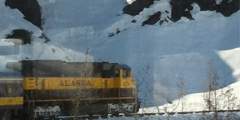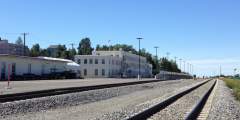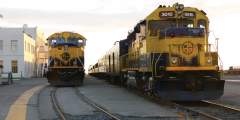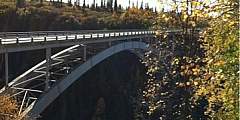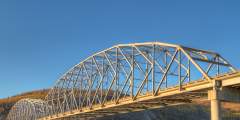Alaska Railroad Highlights Audio Guide
The Alaska Railroad offers passenger service beginning in the town of Seward on the Kenai Peninsula, north to the town of Fairbanks in Alaska's Interior. This audio guide describes some of the highlights during the journey.
Show Map
Points of Interest
The City of Seward is the historic town where the Alaska Railroad got its start. It was the original headquarters of the Engineering Commission, those pioneers that were tasked with the construction of the rail line.
One of the most spectacular and accessible glaciers along the rail line, Spencer Glacier also has an interesting history. Listen to find out how it got it’s name and hear tales of what life was like for those who worked in the wilderness building the rail line.
Built during WWII as a top-secret military project, today Whittier is a great jumping-off place to explore Prince William Sound. To connect Whittier with the rest of the Alaska Railroad, during the war the military constructed a massive tunnel. Today the expanded tunnel is the longest combined rail and highway tunnel in North America.
The United States Congress wanted to open the Territory of Alaska for economic development and recognized the only way that was going to occur was to construct a rail line. Private sector companies attempted to build a rail line but went bankrupt early in the process. Therefore, Congress adopted the Enabling Act of 1914 which authorized the President of United States to locate, construct and operate a 1,000 mile rail line in the Territory.
Anchorage, Alaska’s center of commerce, is the present day headquarters for the Alaska Railroad. The Railroad was granted the land by the US Congress and sold off most of the property in a land auction in 1917. Today, the Railroad has some 600 acres of land reserves remaining in the downtown area of the city. The City of Anchorage exists because of the Railroad.
When the rail line was first constructed the engineering commission used river rock as the surface under where they laid the tracks. Due to the heavy loads the railroad carried, they eventually had to stop using river rock and instead used granite, which they mined in Eklutna. Today the railroad is replacing all the river rock with granite, which they mine from many locations along the rail line.
This bridge is the connection between southcentral Alaska and the interior of the Territory. The bridge represents an engineering marvel for the day and age it was constructed, and is as strong today as when it was constructed nearly a century ago.
The Alaska Railroad was responsible for opening this national park to the public since it provided the only access to the park for many years. The Railroad owned and operated the McKinley Park Hotel from its early beginnings and eventually turned over to the National Park Service for operations. After a fire destroyed the hotel, rail sleeper cars provided a novel lodging opportunity for visitors.
Nenana was the terminus of the Alaska Railroad in 1923 when President Harding traveled to Alaska in July 1923 to drive the “Gold Spike” signifying the completion of constructing the railroad. It is also the starting point for the riverboat operation which was developed and operated by the Railroad to ship materials and supplies to rural villages along the Yukon River. Although the last surviving riverboat can be found on display in… ...more

